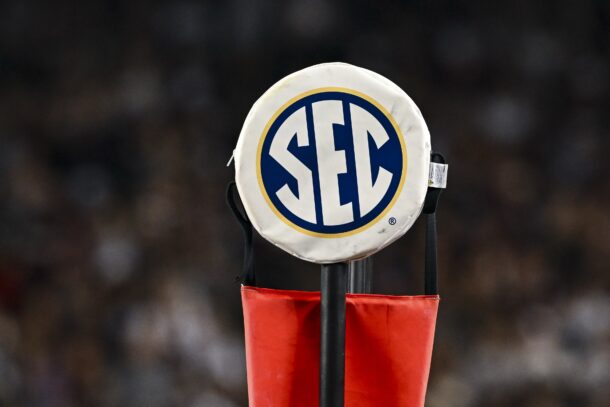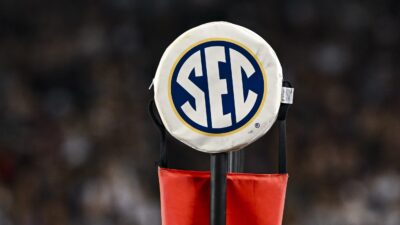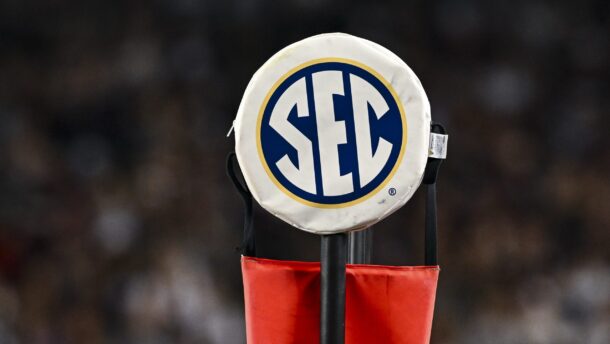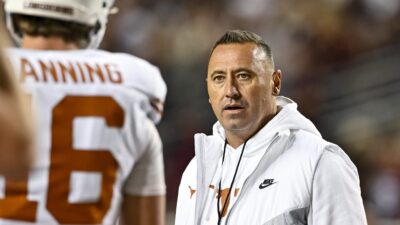
Nobody is perfect. Not even Playoff teams.
Granted, Alabama is close. But even the mighty Crimson Tide have a weakness or 2.
With the Playoff field now set, we can now pick apart these teams and break down what it’ll take for them to falter. Or perhaps this is the most likely way that they’ll falter in a 4-team tournament.
Just so that you don’t assume this is nitpicking too much, we should also point out each team’s biggest strength. As in, what’s the most likely way that they’ll win in a 4-team tournament.
Here’s what that looks like for the field of 4:
Alabama
Biggest strength — Historically prolific offensive balance
This just in — the Alabama offense is pretty darn good. That’s usually the case when you score 35 points in 24 consecutive games. How many games has Steve Sarkisian been the Alabama offensive coordinator? That would be 24 games. The reason why this offense has been so unbelievably consistent is because of its balance.
Heisman candidates at quarterback, receiver and running back certainly help that. In the 10 regular-season games, Alabama’s run-pass ratio was 37-31, which means that 55% of the time, it ran the ball. That number is actually a touch skewed because when you beat every team by at least 15 points, you aren’t doing a ton of throwing down the stretch. That number was probably closer to a 50-50 split.
It’s pretty difficult to defend a team that boasts the most efficient passing attack in America — Mac Jones has a chance to break Kyler Murray’s FBS record for yards per attempt — when it also has the nation’s leader in rushing touchdowns in Najee Harris. Sarkisian has done a masterful job playing to that. His ability to keep defenses off-balanced is why Alabama is a home-run play waiting to happen.
It doesn’t really matter what defenses do. They can drop 8 into coverage, they can try exotic blitz packages or they can load the box to make Jones beat them. Every plan seems like it’s waiting to fall against this historically prolific unit.
And unlike that 2018 Alabama offense, which showed some kinks in the armor against elite defenses down the stretch, there’s no sign that there are cracks in this rock solid foundation.
Biggest weakness — Lack of meaningful late-game experience
You could argue that Alabama’s weakness is its struggles defending teams who actually have downfield passing attacks, but I’d argue it’s not truly a major issue for a team who went over 300 minutes without allowing a passing touchdown.
The lack of late game experience, even after Saturday, is worth mentioning.
I feel like we say this every year, but think about this. Other than Florida in the SEC Championship, which was a blessing for Alabama to finally play in a close game, the Ole Miss game was the only time in which a team finished within 2 scores of Alabama. There were only 3 games in which a team was within 2 scores in the 4th quarter of Alabama this season.
That speaks to how dominant Nick Saban’s team has been, obviously. But it can be a weakness if a team actually forces Alabama to play 60 minutes. There’s a difference between making a clutch throw on 3rd down in the 2nd quarter and putting together a 2-minute drill in a tie game. It helps to have veterans like Jones, Harris and DeVonta Smith, but this is also about making the right calls in tense moments on both sides of the ball.
There’s also the conditioning aspect of what playing 11 games against SEC competition will do. Is Alabama going to have all of its juice late? Or could we be heading for a 2016-like outcome when it looked like that team ran out of gas against Clemson? Time will tell. There’s a reason why Saban still coached like this with massive leads in the final minutes:
Up 45-3 with 3 minutes left. About to clinch 10-0.
Nick Saban, never done coaching. pic.twitter.com/ksxIzyfOb9
— Connor O’Gara (@cjogara) December 12, 2020
Saban’s pursuit for ring No. 7 could come down to that late-game attention to detail.
Ohio State
Biggest strength — No. 1.
No, no, no. Don’t get it twisted. That wasn’t my way of arguing that the Buckeyes are the best team in America; it was my way of arguing that Justin Fields is special … even if he hasn’t been special against good defenses this year.
This isn’t breaking any news to say that the Ohio State quarterback does things that few are capable of. Whether that’s avoiding a free rusher and delivering a 45-yard dart to an in-stride receiver or making something out of nothing on 3rd and 17, Fields can do it all. He might take a couple of extra sacks because of how much he keeps his eyes downfield, but his elusiveness allows for that.
Amidst those 2020 inconsistencies, you still need a quarterback like Fields to win a national championship. Ohio State’s biggest strength is that it has someone who can beat you in so many ways at the game’s most important position. Pretty simple here. I’d also argue that Fields being in Year 2 of Ryan Day’s system matters, too.
If Ohio State is going to win it all, it’ll be because Fields did a lot of the heavy lifting.
Biggest weakness — Defending downfield passing attacks
See Penix, Michael. Not ringing a bell? See Hoosiers, Indiana.
The Hoosiers were able to keep it within a touchdown of the Buckeyes because of plays like this:
Ty Fryfogle cannot be contained 😱 @Ty_Fry3 @IndianaFootball
(via @CFBONFOX) pic.twitter.com/BB7xzJ1Tva
— The Checkdown (@thecheckdown) November 21, 2020
Ohio State’s secondary — and probably its entire defense — is an example of an inexperienced group who really would’ve benefitted from a normal offseason. When you lose stars like Jeff Okudah and Damon Arnette, who were both top-20 picks in the NFL Draft, it’s not a given that a secondary will pick up where it left off even with a veteran like Shaun Wade back there. It’s probably also worth noting that Ohio State’s secondary benefitted from having a generational talent like Chase Young speeding up quarterbacks.
Now, this group hasn’t really had consistent game time to get on the same page. That’s a major, major issue in a Playoff field loaded with teams who are all sorts of prolific with the downfield passing game, especially that No. 16 guy in purple and orange. If Ohio State can’t fix those issues on the back end, this will be another semifinal exit at the hands of Clemson.
Clemson
Biggest strength — No. 16.
With all due respect to the immensely productive Travis Etienne, Trevor Lawrence is the straw that stirs the drink for the Tigers. We saw in last year’s semifinal game when he busted out that long touchdown run that there’s not a play on the football field he can’t make. Nobody in the country is better at throwing strikes working across the left side, and perhaps more importantly, nobody in this field has more big-game experience than Lawrence.
He’s about to start in Playoff game No. 5. That’s a record. That’s also not a coincidence. For all the talk about Lawrence’s next-level skill set, we probably don’t talk enough about what makes him one of the best college quarterbacks of the 21st century. The guy is 34-1 as a starter with his lone loss coming to arguably the best team in college football history (2019 LSU).
In the same way that Fields is always going to give Ohio State to win a game, the same is true for Lawrence. And if anyone should know that, well, it’s Fields.
Biggest weakness — The running game
Wait a minute. Isn’t Clemson the team with one of the top backs in America? How could that be a weakness? It’s been somewhat overlooked nationally that the Tigers haven’t been nearly as productive running the ball this year than they’ve been in the past. Etienne went 6 consecutive games without 100 rushing yards to close the regular season. During that stretch, he averaged just 61 rushing yards. That’s why Etienne went into conference championship weekend ranked No. 70 among FBS halfbacks in run grade, according to Pro Football Focus. Granted, he looked fantastic in the ACC Championship.
Etienne is such a good player that he’s been heavily involved in the passing game (he had the No. 2 receiving grade among FBS backs heading into conference championship weekend). But it’s telling that Etienne had as many 100-yard receiving games as he did 100-yard rushing games during the regular season. Remember when he was held to 28 yards on 18 carries against the Irish in South Bend?
Not a lot of people realize that Clemson went into conference championship weekend with the No. 70 ground attack. And sure, you can say part of that is the reliance on Lawrence, but combine Etienne’s atypical struggles (he’s never had worse than 7.2 yards per carry in a season until 2020) with the fact that the Tigers haven’t really found that change-of-pace back and it’s fair to wonder if the ground game will hold Clemson back.
Then again, Etienne is the guy who has 5 Playoff games under his belt already and is capable of going off at any time. Even if the blocking isn’t there, he’s always a threat to do this:
Travis Etienne shook two defenders for 6
Tough 😤
(via @ClemsonFB)pic.twitter.com/pkiOyIGBMF
— Bleacher Report CFB (@BR_CFB) October 4, 2020
Notre Dame
Biggest strength — Clark Lea’s nasty defense
It’s pretty incredible to think that Mike Elko left Notre Dame for A&M, and then all Lea did after getting promoted was crank out top-15 defenses en route to a Power 5 head coaching gig. A tip of the cap to the SEC’s new head coach is in order. The No. 8 run defense in the regular season was dominant in that double-overtime win against Clemson in which the ACC’s all-time leading rusher, Etienne, was held to just 28 yards on 18 carries.
What was equally impressive was what the Irish did to stuff that prolific North Carolina ground game in Chapel Hill. Michael Carter and Javonte Williams (PFF’s top-graded tailback) were held to just 85 yards. The Irish did that while keeping Sam Howell in check, too.
Besides the run defense, Notre Dame has so many guys who can get after the quarterback, though they aren’t necessarily dependent on that. That’s a good thing. Daelin Hayes has been fantastic as the leader of that defense, as has Adetokunbo Ogundeji. Jeremiah Owusu-Koramoah is still one of the top linebackers in all of college football, too.
There are some who might point to the fact that D.J. Uiagalelei threw for 439 yards in that game and think that Notre Dame doesn’t have a solid defense. No matter what happens in the Playoff, that group is darn good and needs to be taken seriously.
Biggest weakness — Downfield passing
It’s probably not the best sign when your only receiver with legitimate experience entering the season is a Northwestern grad transfer. That’s not a dig at Ben Skowronek, who has been a fine player when healthy. But he’s not going to really stretch out a defense (he has 1 game this year with a catch of 30 yards). Javon McKinley has really stepped up down the stretch with 489 receiving yards in those last 5 regular season games, and it’s really allowed Notre Dame to attack downfield more.
Ian Book 🎯🎯🎯 Javon McKinley
— PFF College (@PFF_College) December 5, 2020
The issue is McKinley’s first game with a touchdown was in the regular season finale against Syracuse. In this field, you’re going to need to hit some home run plays. I’m not sure you can expect to keep up with some of these dynamic offenses if you can’t consistently stretch the field. We saw that happen against Clemson in the ACC Championship.
That’s not really where Ian Book is at his best. He’s not necessarily going to drop it in a bucket the same way that Jones, Lawrence or Fields will. That’s not to say Book can’t make that happen. But Book is in his element when he’s scrambling and making things happen on the move, not so much when he’s attacking elite secondaries when relatively unproven deep-ball pass-catchers.
Something tells me that’ll have to change against Nick Saban’s defense.
Connor O'Gara is the senior national columnist for Saturday Down South. He's a member of the Football Writers Association of America. After spending his entire life living in B1G country, he moved to the South in 2015.







